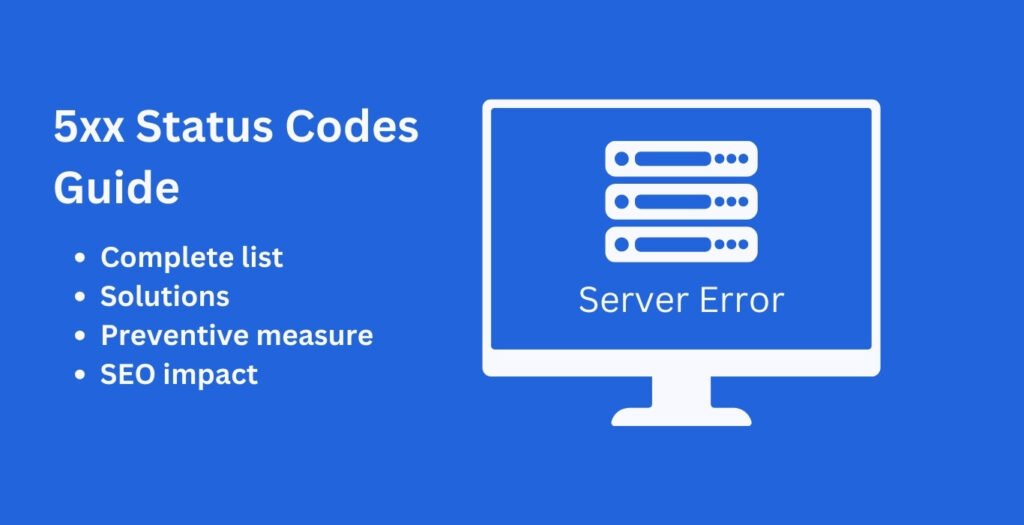When your server encounters errors it cannot resolve, it returns 5xx status codes to users and search engine crawlers. Unlike client-side 4xx errors, 5xx errors indicate problems with your server that prevent it from fulfilling valid requests. These errors can significantly impact your website’s search visibility, user experience, and overall SEO performance.
This guide explains the various 5xx status codes, their implications for SEO, and how to address them effectively.
What are 5xx Status Codes?
5xx status codes indicate server-side errors where the server fails to fulfill an apparently valid request. These errors suggest that the problem lies with the server’s configuration, capacity, or availability rather than with the client’s request.
List of All 5xx Status Codes
| HTTP Status Code | Name | Description |
|---|---|---|
| 500 | Internal Server Error | A generic error message when the server encounters an unexpected condition. |
| 501 | Not Implemented | The server does not support the functionality required to fulfill the request. |
| 502 | Bad Gateway | The server, while acting as a gateway or proxy, received an invalid response from an upstream server. |
| 503 | Service Unavailable | The server is currently unable to handle the request due to temporary overloading or maintenance. |
| 504 | Gateway Timeout | The server, while acting as a gateway or proxy, did not receive a timely response from an upstream server. |
| 505 | HTTP Version Not Supported | The server does not support the HTTP protocol version used in the request. |
| 506 | Variant Also Negotiates | The server has an internal configuration error. |
| 507 | Insufficient Storage | The server is unable to store the representation needed to complete the request. |
| 508 | Loop Detected | The server detected an infinite loop while processing the request. |
| 510 | Not Extended | Further extensions to the request are required for the server to fulfill it. |
| 511 | Network Authentication Required | The client needs to authenticate to gain network access. |
Common 5xx Status Codes and Their Impact on SEO
500 Internal Server Error
Indicates that the server encountered an unexpected condition that prevented it from fulfilling the request.
Example: A PHP script on your website contains errors that crash the server process.
Impact on SEO:
- Prevents search engines from indexing affected pages
- Can lead to deindexing if persistent
- Damages user experience and increases bounce rates
- May cause search engines to crawl your site less frequently
- Wastes crawl budget on pages that cannot be indexed
Resolution Strategies:
- Check server error logs to identify the specific issue
- Review and debug recent code changes
- Ensure proper PHP memory limits and server resources
- Temporarily disable plugins or themes to identify conflicts
- Implement proper error monitoring and alerting systems
503 Service Unavailable
Indicates that the server is temporarily unable to handle the request due to maintenance or overloading.
Example: Your server is experiencing high traffic during a marketing campaign, or you’ve placed the site in maintenance mode.
Impact on SEO:
- When properly implemented with a Retry-After header, signals to search engines that the unavailability is temporary
- Less harmful than other 5xx errors if used correctly
- Can help prevent deindexing during planned maintenance
- Preserves rankings better than showing error pages or incomplete content
Best Practices:
- Always include a Retry-After header with a reasonable timeframe
- Use for planned maintenance windows
- Implement rate limiting to prevent server overload
- Consider CDN implementation for traffic spikes
- Monitor server capacity and scale resources accordingly
502 Bad Gateway
Indicates that the server, while acting as a gateway or proxy, received an invalid response from the upstream server.
Example: Your CDN cannot communicate properly with your origin server, or there’s an issue with your load balancer.
Impact on SEO:
- Prevents proper crawling and indexing
- Creates poor user experience
- May signal infrastructure problems to search engines
- Can lead to crawl budget waste and reduced crawl frequency
Troubleshooting Steps:
- Check the configuration of your proxy server, load balancer, or CDN
- Verify that your origin server is responding correctly
- Review network connectivity between servers
- Ensure timeout settings are appropriate
- Check for mismatched protocols or certificate issues
504 Gateway Timeout
Indicates that the server, while acting as a gateway or proxy, did not receive a timely response from the upstream server.
Example: A script on your website takes too long to execute, exceeding the gateway timeout.
Impact on SEO:
- Prevents complete indexing of affected pages
- Signals performance issues to search engines
- Negatively impacts user experience metrics
- May lead to decreased crawl frequency
Solutions:
- Optimize slow database queries
- Implement caching strategies
- Review and optimize script execution times
- Increase timeout settings if appropriate
- Consider content delivery optimization
How to Detect and Monitor 5xx Errors
- Google Search Console: Check the Coverage report and Crawl Stats report for server errors.
- Server Logs: Review your server’s error logs to identify specific issues.
- Monitoring Tools: Implement uptime monitoring services like Pingdom or New Relic.
- Custom Alerts: Set up alerts for 5xx errors to enable quick response.
- Crawl Tools: Use tools like Screaming Frog to simulate search engine crawling and identify server issues.
SEO Recovery After 5xx Errors
- Fix the Root Cause: Address the underlying server issues before focusing on SEO recovery.
- Request Reindexing: Use Google Search Console to request recrawling of affected URLs.
- Implement Progressive Reindexing: Focus on high-priority pages first to establish stability.
- Monitor Recovery: Track indexation status and organic traffic to affected sections.
- Document Incidents: Keep records of server issues for future prevention and faster response.
Preventive Measures for 5xx Errors
- Regular Server Maintenance: Schedule routine checks and updates during low-traffic periods.
- Load Testing: Test your server’s capacity before major traffic events or campaigns.
- Scalable Infrastructure: Implement auto-scaling solutions to handle traffic spikes.
- Content Delivery Network: Use CDNs to reduce server load and improve reliability.
- Redundancy Plans: Develop backup systems and failover mechanisms.
- Monitoring Systems: Implement 24/7 monitoring with immediate alerts for server issues.
FAQs
How quickly do 5xx errors impact SEO? Temporary 5xx errors (lasting a few hours) typically have minimal SEO impact. However, persistent errors lasting multiple days can lead to deindexing and ranking drops within 1-2 weeks.
Should I implement redirects for pages experiencing 5xx errors? No. Fix the server issues instead. Redirecting from pages with server errors can create redirect chains and confusion for search engines.
How do 5xx errors differ from 4xx errors in terms of SEO impact? 5xx errors indicate server problems and suggest instability, potentially affecting your entire site’s credibility. 4xx errors are typically isolated to specific resources and don’t necessarily indicate site-wide issues.
Will a brief 5xx error during a site update hurt my rankings? Brief, planned downtime with proper 503 status codes and Retry-After headers should have minimal impact on rankings. Search engines are designed to accommodate reasonable maintenance windows.
How can I prioritize which 5xx errors to fix first? Focus on errors affecting:
- Your homepage and main landing pages
- High-traffic pages
- Pages with significant backlinks
- Critical conversion paths
- Pages explicitly listed in your XML sitemap


